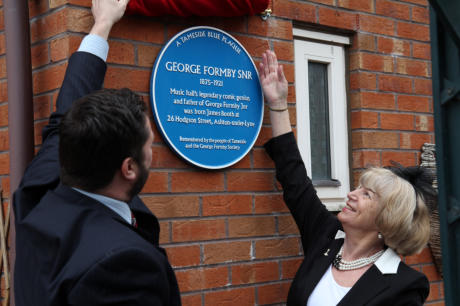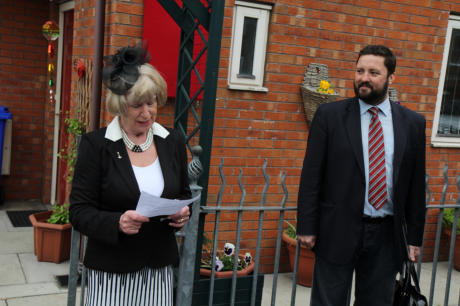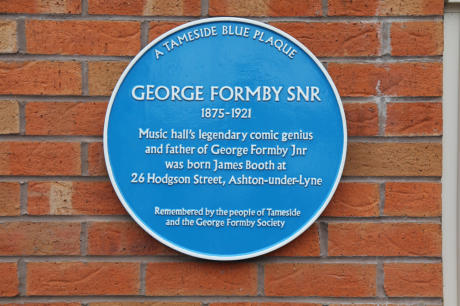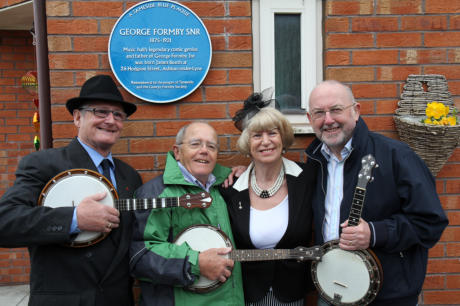


Marking George’s last home in Lytham
A blue plaque has been unveiled at George
Formby's last address in Lytham St Annes at
199 Fairhaven.
George lived here from 1953 until his death
in March 1961. The house was previously
owned by singing star Josef Locke.
Unfortunately it has been noted that Josef's
christian name is incorrectly spelt.
Like all George's homes, 199 Fairhaven was
called 'Beryldene' after George's wife Beryl.
President of the GFS, Gerry Mawdsley and
members of the GFS assisted the Mayor of
Fylde Coun Heather Speak and St Anne’s
Mayor Coun Angela Jacques and Marion
Coupe of Lytham St. Anne’s Civic Society in
making it a special day.
This was an unexpected but welcome event
and follows closely on from the hard fought
achievement of George's father being
awarded a Blue Plaque in Ashton-under-
Lyme.
This plaque now represents the third blue
plaque for George and his father.
Vivien Mawdsley was on hand to capture
images of the day.

Honouring George Formby Snr.
Another red letter day for all lovers of the world of George
Formby took place on Saturday June 2nd 2012 when at long
last, long overdue recognition of one of the greatest entertainers
that England has ever produced was finally put right with the
unveiling of a Blue Plaque to mark the birthplace of James Booth
- better know to all as George Formby Snr.
The plaque was unveiled on the corner of Hodgson Street,
Ashton-Under-Lyne, near to were James Booth was born in
1875.
Those who attended the occasion (local people, members of the
GFS and the media) were entertained by music from George
Formby Jnr’s repertoire, ably played by members of The George
Formby Society who were led by GFS President Gerry
Mawdsley.
Ryan Williams, one of the people who organised the event,
welcomed everyone and gave a very interesting background to
George Formby Snr’s life in the local area. He then welcomed
George Formby’s granddaughter Mrs Geraldine Smith (daughter
of Ethel) who performed the official unveiling.
In the panel (below and right) read Ryan’s words on the day, very appropriately giving a concise local history of James Booth and his times in
Ashton.
May 31st 1998 is to be a red letter day in the history of the Society and the name of George Formby. On that day, there is to be a
unveiling of a plaque in the town of Wigan when finally the councilors of Wigan (George Formby's hometown) will recognize one of
Wigan's most famous son's.
The event is taking place only after many years of campaigning by long time Society member, Gerry Mawdsley who has worked
tirelessly to gain the recognition that George Formby obviously deserves.
The plaque commemorating George Formby and his birthplace will be unveiled by Ted Formby, George's youngest brother, and the
Mayor of Wigan, Councilor S. Little on Sunday 31st May at 12 noon.
The plaque will be sited on the retaining wall adjacent to the pavement of the new road named Central Park Way and the Douglas
Valley Nursery - opposite Central Park Rugby Ground. It is almost exactly the spot which was occupied by 3, Westminster Street
where George Formby was born.
After the unveiling, we shall all retire to the Grand Hotel for a celebratory concert of Formby songs performed by members of the
Society. A good time is guaranteed!
Just to make sure there is no confusion, this event took place some years ago and remains here for archive purposes.
The Wigan Plaque

To appreciate the work of George Formby Snr, please listen to one
of his best known recordings, Standing At The Corner Of The
Street
RYAN WILLIAMS’ SPEECH
We've gathered here today, on a weekend of celebrations and commemorations, to host our very own. All over the country today, people are beginning their own celebrations. And I'm delighted to begin my weekend here with you all. Not to celebrate a queen, but to remember a king. A king of entertainment. A legend of the music hall era. George Formby senior. Again, let me thank you all for your company here this morning and for joining us in these very special celebrations. Trevor Rowley, (Tameside resident from Mossley), was astounded to learn while researching George Formby Senior that not only was he born, here in Ashton, but that this fact had not been recognised in any way. So, he put forward a nomination for a blue plaque. A nomination that, when considered by Tameside Council, was subsequently rejected. Not on the grounds that… “not every nomination can be successful” but as stated in their letter that George Formby Senior was “not unique” or outstanding enough. Well, on grounds such as that, how could the decision not be appealed? Unfortunately, despite the appeal, the decision by the vetting panel stood and they upheld their refusal. Not to be discouraged Trevor contacted local authors and brothers Philip & David Williams. Known in the local community and beyond, for their books on various aspects of northern life, local history and music hall and theatre, Trevor hoped the Williams brothers may have ideas for another "line of attack". And Together, the three of them came up with the idea of a public subscription to fund the plaque. And, after months of hard work, I'm delighted that we now find ourselves here today. George Formby senior, was born in to poverty, hardship and depravation in the Ashton-under-Lyne of 1875. Despite suffering chronic bronchial problems since early childhood, sheer hard work and determination saw his star ascend... Right to the very top. He developed into one of the biggest names and highest earners in British music hall and twice performed before the King and Queen at their personal request. At the time of his death in 1921 he left behind a diary with enough advanced bookings to have taken him well into 1926. He also left a staggering £26,000 which, like the man himself, and despite what anyone would try to have us believe, was unique for the time, and I think it's fair to say, was pretty outstanding too. At the peak of his career George Formby senior was, in all probability, even more illustrious than his ukulele playing film star son was to become during the 1940s and 50s. With his character creation of ‘John Willie’, dressed in a clown-like baggy suit, George Formby senior captivated audiences everywhere. He was the first to talk of ‘Wigan Pier’, implying that the land locked industrial Lancashire town had its own seaside style pier. In reality this was just a small wharf on the Leeds and Liverpool canal, similar in fact to Ashton’s Portland Basin. He also coined the popular adage, still quoted by many today, “It’s not the cough that carries you off, it’s the coffin they carries you off in”. This, together with another catchphrase “I’m coughin’ better tonight” and his real bronchial cough were to became his trademarks. In fact, though he was beloved by audiences the country over, few realised just how much he suffered in order to entertain them. He never let it be known how ill he really was. The man we know as George Formby Senior was actually born James Booth - here on Hodgson Street at number 26 in 1875. The house outside which we are standing today is on the spot where the Music Hall Inn once stood and where in his teenage years the young ‘Jim’ Booth performed. It is well known that Formby had a very miserable childhood. He was the illegitimate son of a teenage Sarah Jane Booth. When he was just about 6 months old, his mother married Frank Lawler at St. Peter’s Church – just across the way. It is believed that Frank was actually the boy’s father and shortly after the marriage young ‘Jim’ was to take the Lawler surname. As parents the Lawler’s failed on a grand scale, their love of alcohol seemingly deeper than the love for their son. The marriage was a stormy and violent affair and for young Jim the family home was one filled with endless drunken quarrels and fights and where he was often half-starved and continually ill-treated. He developed severe asthmatic and bronchial problems from the age of seven, a condition which remained with him throughout his life. His suffering was not helped by the fact that he was forced to endure many nights sleeping on the doorstep of his terraced home or on the cold stone floor of the communal lavatory. This neglecting meant that he was often reduced to singing in the streets of Ashton in the hope of earning a few pennies to buy food. Home life didn’t improve any even after the death of his father at the young age of 33. Much of the money earned by his mother was being squandered to feed her drinking habit. After a stint working in Cryer’s Iron Works, which he left due to the affects on his health, and a brief spell on a market garden he soon found that he could earn enough money to survive by singing in the ‘free and easies’ at the local public houses. It was in 1892 at the Spread Eagle pub, where the Lidl supermarket now stands, that theatrical agent Mr Brown first took him under his wing, teaming him up with another youngster to create the Brothers Glenray. Traveling the north of England as one half of the singing duo became the escape route from his mother. He once said, that he could remember as miserable a childhood as ever fell to the lot of a human creature, with parents that allowed him to go his own way and of being absolutely uncared for. Yet, leaving Ashton was no reflection on the town itself. It was simply a means of severing his family ties. He would never forget the town of his birth and returned on many occasions to play the inns and music halls on his way to stardom. He would also return later in his career, to play Ashton’s theatres as George - one of the biggest and best-loved stars in the country. And he always referred to the townsfolk of Ashton as “my people”. 95 years ago this month during the First World War, Ashton was rocked by a huge explosion in a local munitions factory. Forty-six people lost their lives in the explosion, over 100 more were hospitalised with many more made homeless. If you look behind you [Note: from position on Hodgson Street where everyone will be standing] you will be able to see the Memorial Sculpture by Paul Margetts, which marks the event. Formby’s affinity with Ashton and its people came to the fore in the wake of this disaster when a relief fund was established to raise money for victims and families of the bereaved. Formby offered to perform a matinee at the Theatre Royal with all proceeds going to the fund. He was unwell at the time and his management were trying to dissuade him from appearing. But he wouldn't be deterred and performed his act in front of a full house and even auctioned off a signed playbill and a bag of sugar, which at the time was a very scarce and rare commodity. From 1918 onwards his health became progressively worse and he eventually succumbed to the tuberculosis that had plagued him for years. He died on February 8th 1921. It gives me great pleasure to be here today, remembering a man who was always so quick to remember the people of his hometown, Ashton. Of course the placing of this plaque wouldn’t have been possible without the help of several people. These include Trevor Rowley whose idea it was. Well known local authors Philip & David Williams. Councillor Joyce Bowerman for joining us. Peter Marland, Nicola Woods and Clare Leader at Ashton Pioneer Homes – The Housing Association which owns these properties. Also thanks to Donna Flanagan, and her daughters Leah and Natalie OF 65 WELBECK STREET for allowing the plaque to be fixed to their home, and to the many people who contributed to the fund especially Gerry Mawdsley and members of the George Formby Society. And now I’d like to introduce our special guest of honour, to perform the unveiling. Granddaughter of George Formby senior... Ladies & Gentlemen… please welcome Geraldine Smith. It just remains for me to thank Geraldine for unveiling this plaque, the George Formby society for the musical entertainment, for everyone that helped make this possible - and of course to all of you who have shared this morning's celebrations.

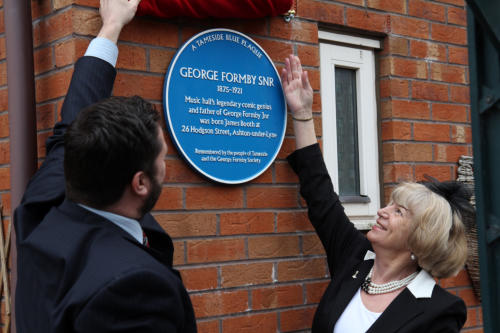

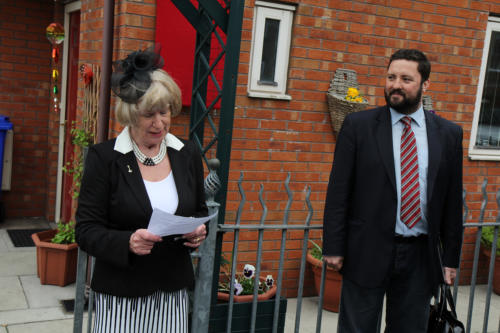





A blue plaque has been unveiled at George Formby's last address
in Lytham St Annes at 199 Fairhaven.
George lived here from 1953 until his death in March 1961. The
house was previously owned by singing star Josef Locke.
Unfortunately it has been noted that Josef's christian name is
incorrectly spelt.
Like all George's homes, 199 Fairhaven was called 'Beryldene'
after George's wife Beryl.
President of the GFS, Gerry Mawdsley and members of the GFS
assisted the Mayor of Fylde Coun Heather Speak and St Anne’s
Mayor Coun Angela Jacques and Marion Coupe of Lytham St.
Anne’s Civic Society in making it a special day.
This was an unexpected but welcome event and follows closely on
from the hard fought achievement of George's father being
awarded a Blue Plaque in Ashton-under-Lyme.
This plaque now represents the third blue plaque for George and
his father.
Vivien Mawdsley was on hand to capture images of the day.

Another red letter day for all lovers of the world of George Formby
took place on Saturday June 2nd 2012 when at long last, long
overdue recognition of one of the greatest entertainers that England
has ever produced was finally put right with the unveiling of a Blue
Plaque to mark the birthplace of James Booth - better know to all
as George Formby Snr.
The plaque was unveiled on the corner of Hodgson Street, Ashton-
Under-Lyne, near to were James Booth was born in 1875.
Those who attended the occasion (local people, members of the
GFS and the media) were entertained by music from George
Formby Jnr’s repertoire, ably played by members of The George
Formby Society who were led by GFS President Gerry Mawdsley.
Ryan Williams, one of the people who organised the event,
welcomed everyone and gave a very interesting background to
George Formby Snr’s life in the local area. He then welcomed
George Formby’s granddaughter Mrs Geraldine Smith (daughter of
Ethel) who performed the official unveiling.
In the panel (below and right) read Ryan’s words on the day, very
appropriately giving a concise local history of James Booth and his
times in Ashton.
May 31st 1998 is to be a red letter day in the history of the
Society and the name of George Formby. On that day, there is
to be a unveiling of a plaque in the town of Wigan when finally
the councilors of Wigan (George Formby's hometown) will
recognize one of Wigan's most famous son's.
The event is taking place only after many years of
campaigning by long time Society member, Gerry Mawdsley
who has worked tirelessly to gain the recognition that George
Formby obviously deserves.
The plaque commemorating George Formby and his
birthplace will be unveiled by Ted Formby, George's youngest
brother, and the Mayor of Wigan, Councilor S. Little on
Sunday 31st May at 12 noon.
The plaque will be sited on the retaining wall adjacent to the
pavement of the new road named Central Park Way and the
Douglas Valley Nursery - opposite Central Park Rugby
Ground. It is almost exactly the spot which was occupied by 3,
Westminster Street where George Formby was born.
After the unveiling, we shall all retire to the Grand Hotel for a
celebratory concert of Formby songs performed by members
of the Society. A good time is guaranteed!
Just to make sure there is no confusion, this event took
place some years ago and remains here for archive
purposes.

To appreciate the work of George Formby Snr, please listen to one
of his best known recordings, Standing At The Corner Of The
Street
RYAN WILLIAMS’ SPEECH
We've gathered here today, on a weekend of celebrations and commemorations, to host our very own. All over the country today, people are beginning their own celebrations. And I'm delighted to begin my weekend here with you all. Not to celebrate a queen, but to remember a king. A king of entertainment. A legend of the music hall era. George Formby senior. Again, let me thank you all for your company here this morning and for joining us in these very special celebrations. Trevor Rowley, (Tameside resident from Mossley), was astounded to learn while researching George Formby Senior that not only was he born, here in Ashton, but that this fact had not been recognised in any way. So, he put forward a nomination for a blue plaque. A nomination that, when considered by Tameside Council, was subsequently rejected. Not on the grounds that… “not every nomination can be successful” but as stated in their letter that George Formby Senior was “not unique” or outstanding enough. Well, on grounds such as that, how could the decision not be appealed? Unfortunately, despite the appeal, the decision by the vetting panel stood and they upheld their refusal. Not to be discouraged Trevor contacted local authors and brothers Philip & David Williams. Known in the local community and beyond, for their books on various aspects of northern life, local history and music hall and theatre, Trevor hoped the Williams brothers may have ideas for another "line of attack". And Together, the three of them came up with the idea of a public subscription to fund the plaque. And, after months of hard work, I'm delighted that we now find ourselves here today. George Formby senior, was born in to poverty, hardship and depravation in the Ashton-under-Lyne of 1875. Despite suffering chronic bronchial problems since early childhood, sheer hard work and determination saw his star ascend... Right to the very top. He developed into one of the biggest names and highest earners in British music hall and twice performed before the King and Queen at their personal request. At the time of his death in 1921 he left behind a diary with enough advanced bookings to have taken him well into 1926. He also left a staggering £26,000 which, like the man himself, and despite what anyone would try to have us believe, was unique for the time, and I think it's fair to say, was pretty outstanding too. At the peak of his career George Formby senior was, in all probability, even more illustrious than his ukulele playing film star son was to become during the 1940s and 50s. With his character creation of ‘John Willie’, dressed in a clown-like baggy suit, George Formby senior captivated audiences everywhere. He was the first to talk of ‘Wigan Pier’, implying that the land locked industrial Lancashire town had its own seaside style pier. In reality this was just a small wharf on the Leeds and Liverpool canal, similar in fact to Ashton’s Portland Basin. He also coined the popular adage, still quoted by many today, “It’s not the cough that carries you off, it’s the coffin they carries you off in”. This, together with another catchphrase “I’m coughin’ better tonight” and his real bronchial cough were to became his trademarks. In fact, though he was beloved by audiences the country over, few realised just how much he suffered in order to entertain them. He never let it be known how ill he really was. The man we know as George Formby Senior was actually born James Booth - here on Hodgson Street at number 26 in 1875. The house outside which we are standing today is on the spot where the Music Hall Inn once stood and where in his teenage years the young ‘Jim’ Booth performed. It is well known that Formby had a very miserable childhood. He was the illegitimate son of a teenage Sarah Jane Booth. When he was just about 6 months old, his mother married Frank Lawler at St. Peter’s Church – just across the way. It is believed that Frank was actually the boy’s father and shortly after the marriage young ‘Jim’ was to take the Lawler surname. As parents the Lawler’s failed on a grand scale, their love of alcohol seemingly deeper than the love for their son. The marriage was a stormy and violent affair and for young Jim the family home was one filled with endless drunken quarrels and fights and where he was often half-starved and continually ill-treated. He developed severe asthmatic and bronchial problems from the age of seven, a condition which remained with him throughout his life. His suffering was not helped by the fact that he was forced to endure many nights sleeping on the doorstep of his terraced home or on the cold stone floor of the communal lavatory. This neglecting meant that he was often reduced to singing in the streets of Ashton in the hope of earning a few pennies to buy food. Home life didn’t improve any even after the death of his father at the young age of 33. Much of the money earned by his mother was being squandered to feed her drinking habit. After a stint working in Cryer’s Iron Works, which he left due to the affects on his health, and a brief spell on a market garden he soon found that he could earn enough money to survive by singing in the ‘free and easies’ at the local public houses. It was in 1892 at the Spread Eagle pub, where the Lidl supermarket now stands, that theatrical agent Mr Brown first took him under his wing, teaming him up with another youngster to create the Brothers Glenray. Traveling the north of England as one half of the singing duo became the escape route from his mother. He once said, that he could remember as miserable a childhood as ever fell to the lot of a human creature, with parents that allowed him to go his own way and of being absolutely uncared for. Yet, leaving Ashton was no reflection on the town itself. It was simply a means of severing his family ties. He would never forget the town of his birth and returned on many occasions to play the inns and music halls on his way to stardom. He would also return later in his career, to play Ashton’s theatres as George - one of the biggest and best-loved stars in the country. And he always referred to the townsfolk of Ashton as “my people”. 95 years ago this month during the First World War, Ashton was rocked by a huge explosion in a local munitions factory. Forty-six people lost their lives in the explosion, over 100 more were hospitalised with many more made homeless. If you look behind you [Note: from position on Hodgson Street where everyone will be standing] you will be able to see the Memorial Sculpture by Paul Margetts, which marks the event. Formby’s affinity with Ashton and its people came to the fore in the wake of this disaster when a relief fund was established to raise money for victims and families of the bereaved. Formby offered to perform a matinee at the Theatre Royal with all proceeds going to the fund. He was unwell at the time and his management were trying to dissuade him from appearing. But he wouldn't be deterred and performed his act in front of a full house and even auctioned off a signed playbill and a bag of sugar, which at the time was a very scarce and rare commodity. From 1918 onwards his health became progressively worse and he eventually succumbed to the tuberculosis that had plagued him for years. He died on February 8th 1921. It gives me great pleasure to be here today, remembering a man who was always so quick to remember the people of his hometown, Ashton. Of course the placing of this plaque wouldn’t have been possible without the help of several people. These include Trevor Rowley whose idea it was. Well known local authors Philip & David Williams. Councillor Joyce Bowerman for joining us. Peter Marland, Nicola Woods and Clare Leader at Ashton Pioneer Homes – The Housing Association which owns these properties. Also thanks to Donna Flanagan, and her daughters Leah and Natalie OF 65 WELBECK STREET for allowing the plaque to be fixed to their home, and to the many people who contributed to the fund especially Gerry Mawdsley and members of the George Formby Society. And now I’d like to introduce our special guest of honour, to perform the unveiling. Granddaughter of George Formby senior... Ladies & Gentlemen… please welcome Geraldine Smith. It just remains for me to thank Geraldine for unveiling this plaque, the George Formby society for the musical entertainment, for everyone that helped make this possible - and of course to all of you who have shared this morning's celebrations.



Honouring George Formby Snr
The Wigan Plaque
